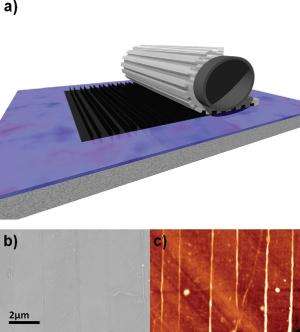December 19, 2013 feature
Graphene origami opens up new spintronics features

(Phys.org) —Despite graphene's many impressive properties, its lack of a bandgap limits its use in electronic applications. In a new study, scientists have theoretically shown that a bandgap can be opened in graphene by folding 2D graphene sheets origami-style and exposing them to a magnetic field. In addition to opening up a bandgap, this method also produces spin-polarized current in the graphene sheets, making them attractive for spintronics applications.
The scientists, A. T. Costa, et al., from institutions in Brazil, Ireland, Singapore, and the US, have published their paper on graphene origami in a recent issue of EPL.
"While bandgap opening and spin-polarized currents are two separate features contained in the wish list of every graphene researcher, we have identified a way that might tick both boxes at once," coauthor Mauro Ferreira, Associate Professor at Trinity College Dublin, told Phys.org.
Since the bandgap is an energy range where no electron states exist, opening a bandgap in graphene transforms it from a conducting material to a semiconducting material. Semiconducting graphene would be more useful, and could have particularly interesting applications for spintronics devices, which exploit the electron's quantum mechanical property of spin in addition to its property of electric charge.
One reason that graphene is a promising spintronics material is that, compared to other materials, it has an extremely small spin-orbit interaction (SOI). This means that its spin interacts very little with its orbital motion, and so spin dissipation is practically negligible in graphene. As a result, information stored in graphene's spin can be retained for considerably longer times than in other materials. A small SOI also means that the information can travel over long distances with very little loss.
Although a small SOI has many advantages, here the scientists wanted to increase the SOI in parts of graphene because doing so is necessary for opening a bandgap. Recent research has demonstrated that SOI is enhanced when graphene is mechanically bent. Here, the researchers theoretically showed that a 2D graphene sheet molded into periodic ridges and troughs has an enhanced SOI in the curved regions.
Increasing the SOI is half of the process to inducing a bandgap; the other half is applying a magnetic field. As the researchers explain, the SOI and magnetic field complement each other in such a way that both quantities must be enhanced to induce a bandgap. The magnitude of the bandgap is ultimately determined by the smaller of these two quantities.
One way that a magnetic field can be applied is by doping the graphene with magnetic atoms. Doping is also another way to enhance SOI, so the whole process could potentially be achieved by doping with the right adsorbants.
This method has some advantages compared to previous attempts to open up a bandgap in graphene. So far, previous methods have failed to produce technologically relevant semiconducting graphene for several reasons, including that the bandgap size is too small and that disorder emerges into the system. The researchers here predict that the new method may overcome these difficulties and finally achieve useful semiconducting graphene.
The second important effect of the new method—that it spin-polarizes the current—means that the electrons' spins are aligned in the same direction. This feature is particularly important for engineering spintronics devices.
In their current study, the researchers showed that the new process can be easily realized by depositing graphene sheets on a substrate with periodic trenches. In the future, they plan to perform measurements on the resulting graphene's electrical properties.
"While we have good experimental control on how the graphene sheets are folded, to measure the transport properties of such origami-like structures remains challenging," Ferreira said. "The next step is to adapt some of the transport measurement techniques to deal with the structures in this new geometry."
More information: A. T. Costa, et al. "Origami-based spintronics in graphene." EPL, 104 (2013) 47001. DOI: 10.1209/0295-5075/104/47001
Journal information: Europhysics Letters (EPL)
© 2013 Phys.org. All rights reserved.




















